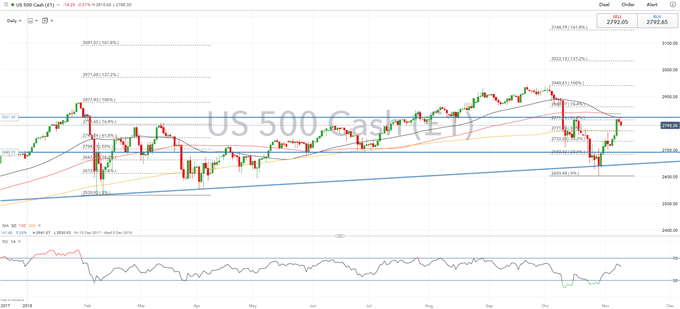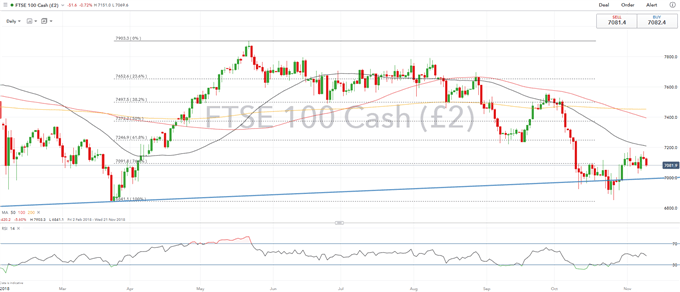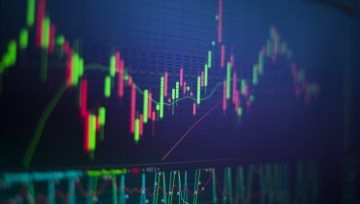Equity Analysis and News
- Midterm Election Over, Attention Back on Trade Wars
- Brexit Headline Risk Increasingly Volatile
- S&P 500 | Key Fibo Renews Selling
- FTSE 100 | Return to Trendline Support Back on the Cards
| Price | 200DMA | RSI | IG Sentiment | |
|---|---|---|---|---|
| Europe | ||||
| FTSE 100 | 7092 | 7413 | 57 | Mixed |
| DAX | 11454 | 12378 | 48 | Bearish |
| CAC 40 | 5085 | 5344 | 54 | Mixed |
| FTSE MIB | 19189 | 21826 | 57 | - |
| US | ||||
| S&P 500 | 2792 | 2761 | 54 | Bullish |
| DJIA | 26074 | 25080 | 59 | Bullish |
| Nasdaq 100 | 7101 | 7131 | 50 | - |
| Asia | ||||
| Nikkei 225 | 22111 | 22453 | 47 | - |
| Shanghai Composite | 2598 | 2989 | 60 | - |
| ASX 200 | 5882 | 6058 | 49 | - |
Midterm Election Over, Attention Back on Trade Wars
The Midterm election saw the Republican’s retain the Senate, however, lost the House to the Democrats, increasing the likelihood of a political gridlock. Although, despite the outcome, the trade outlook remains the same with the Trump administration set to reaffirm its tough stance against China. Prior to the midterm election, reports had circulated that Trump had told officials to draft a deal with China, however, immediately after the election, the Trump administration announced it would put duties on Chinese aluminum sheet products, consequently reducing optimism that a trade deal would be possible in the near-term.
Brexit Headline Risk Increasingly Volatile
Brexit newsflow continues to oscillate between deal optimism and cliff edge Brexit. As such, until a tangible deal is made, UK assets are likely to fade optimism. Headline risk remains elevated with market participants looking out for the next Brexit news to dictate price action.
S&P 500 | Key Fibo Renews Selling
On Wednesday, the S&P 500 saw its largest post midterm election bounce since 1982, having closed over 2% higher. However, volumes had been roughly 15% lower than the 20-day average, which in turn suggested that there had been a lack of conviction behind the buying. At the same time, the rise in the cyclical/defensive sector had come to a halt, increasing the possibility of a slight pullback from its recent recovery. On the technical front, history may indeed be repeating itself with the S&P 500 struggling to get above the 61.8% Fibonacci Retracement from the October sell-off. Back in February, the S&P 500 had also faltered initially at the 61.8% Fibonacci Retracement before a more pronounced rejection at 76.4%.
S&P 500 Price Chart: Daily Time Frame (Dec 2017 – Nov 2018)

FTSE 100 | Return to Trendline Support Back on the Cards
7200 proved a stretch too far for the FTSE 100 with the index failing to keep the upward momentum going. Support at 7091, which marks the 76.4% Fibonacci retracement of the 2018 low to 2018 high, has stemmed further declines so far. However, as uncertainty over Brexit continuing to cloud the outlook for UK assets, a return to the rising trendline from the 2018 low (6841) seems plausible.
FTSE 100 Price Chart: Daily Time Frame (Feb-Nov 2018)

RESOURCES FOR FOREX & CFD TRADERS
Whether you are a new or experienced trader, we have several resources available to help you; indicator for tracking trader sentiment, quarterly trading forecasts, analytical and educational webinars held daily, trading guides to help you improve trading performance, and one specifically for those who are new to forex.
--- Written by Justin McQueen, Market Analyst
To contact Justin, email him at Justin.mcqueen@ig.com
Follow Justin on Twitter @JMcQueenFX






